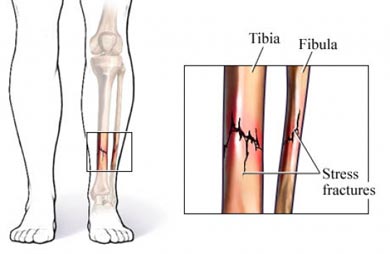


Analgesics are appropriate to relieve pain, and pneumatic bracing can be used to facilitate healing. Treatment of stress fractures consists of activity modification, including the use of nonweight-bearing crutches if needed for pain relief. Both modalities have a similar sensitivity, but magnetic resonance imaging has greater specificity. If an urgent diagnosis is needed, triple-phase bone scintigraphy or magnetic resonance imaging should be considered. When stress fracture is suspected, plain radiography should be obtained initially and, if negative, may be repeated after two to three weeks for greater accuracy. Medial tibial stress syndrome (shin splints) can be distinguished from tibial stress fractures by diffuse tenderness along the length of the posteromedial tibial shaft and a lack of edema. The differential diagnosis varies based on location, but commonly includes tendinopathy, compartment syndrome, and nerve or artery entrapment syndrome. Stress fractures should be considered in patients who present with tenderness or edema after a recent increase in activity or repeated activity with limited rest. These injuries occur more commonly in lower extremities than in upper extremities. Stress fractures are common injuries in athletes and military recruits.


 0 kommentar(er)
0 kommentar(er)
